With the first Genesis, launched as a 2009 model, Hyundai sought to prove it could design and manufacture a viable luxury sedan. They have sold more of them than many people expected, partly because the car was pretty good, but mostly because it cost far less than other rear-wheel-drive luxury sedans. For the 2015 model year Hyundai has redesigned the Genesis, and the changes extend far beyond evolutionary tweaks. Virtually everything save the engines and transmission is all-new. The far loftier goal this time around: a luxury sedan that matches, even beats competitors that remain far more expensive. Have they succeeded?
For this review, I had an hour of seat time in a Genesis 5.0, with the V8 engine, and shorter amounts of time in two Genesis 3.8s, one with a newly developed all-wheel-drive system. This review will focus on the 5.0. I hope to later review the 3.8 AWD based on a longer loan. The comparison car: the only other powerful rear-wheel-drive midsize luxury sedan I've driven recently, and the winner of some recent comparison tests, Cadillac's new-for-2014 CTS Vsport.
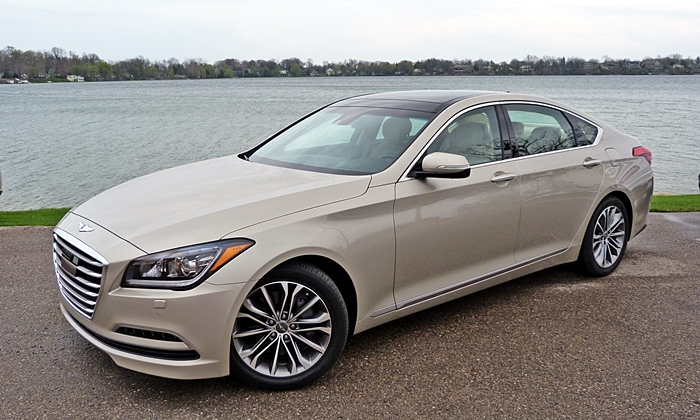
A good angle, accentuating the strong forms through the body side while shrinking the heavy tail. more Genesis photos
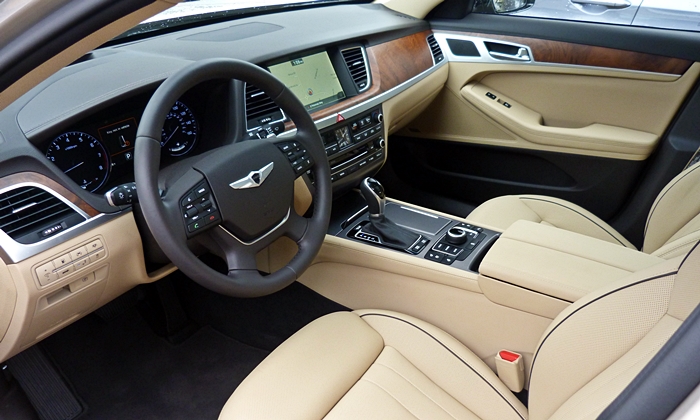
Very warm interior with tan leather, brown piping, and extensive matte-finished wood.
| |
Compared to the CTS |
| Price or payments |
 Better
Worse
Better
Worse
|
Not that the new Genesis isn't far better than the first one. It is. But its list price remains so much lower than everyone else's (save the near-luxury Chrysler 300's) that this price remains the #1 reason to buy a Hyundai Genesis.
(Not interested in the details? Skip to the next section. Interested? Read on!)
The 2015 Genesis 3.8 starts at $38,950. While $2,830 more than the starting price of the 2014 Genesis, the new car also includes about $2,300 in additional standard features, including nav. Adjust for these, and the price of the new and improved car is only up a small amount.
All-wheel-drive, offered only with the 3.8, includes a heated steering wheel, heated rear seat, and headlight washers--none of which are available otherwise. It adds $2,500.
Two option packages that list for $4,000 and $3,500 are standard on the 5.0. These include: a panoramic sunroof, ventilated front seats with upgraded leather, seat memory and adjustable side bolsters for the driver, xenon headlights, a 900-watt Lexicon audio system, adaptive cruise control, sun shades, and a full array of safety aids.
Let's assume you want all of this stuff. How much extra does the V8 cost you? Given the 5.0's $52,450 base price, that answer would be $6,000. Granted, this price also includes larger wheels, fog lights, illuminated door sill trim plates, and real wood trim with a matte finish, but this is double what Hyundai charged for two more cylinders back in 2009, and more in line with competitors.
A third option package with an upgraded nav system, a slightly better Lexicon audio system, head-up display, and the industry's first CO2 sensor lists for $3,500 on the 3.8 (where it also adds the matte wood) and $3,250 on the 5.0 (where it also includes adaptive dampers). The tested Genesis 5.0 had this package, and consequently listed for $55,700.
Seem like a lot of money for a Hyundai Genesis, given that this car launched in the low 30s? Well, it's still ten grand shy of a fully optioned Hyundai Equus or Kia K900.
Then there's the non-Korean competition. A CTS Vsport Premium lists for $69,995, over $14,000 more than the Hyundai. Some additional features on the Cadillac account for only about $2,000 of this difference.
The situation gets trickier with the Germans. As we'll discuss below, the Genesis 5.0 can't match the performance of their turbocharged V8s. Instead, the 420-horsepower Genesis 5.0 struggles to match the performance of an Audi A6 3.0T. That Audi's supercharged V6 is allegedly only good for 310 horsepower, but its performance suggests much more. (The Cadillac is quicker than the Audi, but not by nearly as much as its specs suggest.) When similarly equipped, the A6 3.0T lists for $11,995 more, about $2,400 of it due to additional content--chiefly all-wheel-drive. Need all-wheel-drive, but not the V8? The Genesis then lists for $14,495 less than the Audi, and feature differences explain only about a grand of this amount.
The numbers are even more in the Hyundai's favor when it's compared to the BMW 5-Series or Mercedes-Benz E-Class, especially if you focus on cylinder count.
| Safety & braking |
 Better
Worse
Better
Worse
|
Hyundai focused a tremendous amount of effort on achieving top safety scores with the new Genesis, and the Insurance Institute of Highway Safety (IIHS) has already awarded the car its highest rating. Beyond good scores in every crash test, the Genesis can be purchased with a full array of effective safety aids, including low- and high-speed automatic braking to avoid a front collision. Plus one industry first: the top option package includes a sensor that automatically adds fresh air to the cabin if CO2 reaches a high enough level to induce drowsiness.
The Cadillac CTS has received good scores in two tests, but hasn't yet but subjected to five others (including two for its automatic braking system). Apparently GM (along with Audi, BMW, Infiniti, Lexus, and Mercedes) hasn't been as quick to provide the IIHS with enough cars to conduct all of its tests...
In this segment, only the Acura RLX and Volvo S80 have been subjected to all of the tests, and their automatic braking systems only reduced the speed of impact rather than avoiding the collision entirely.
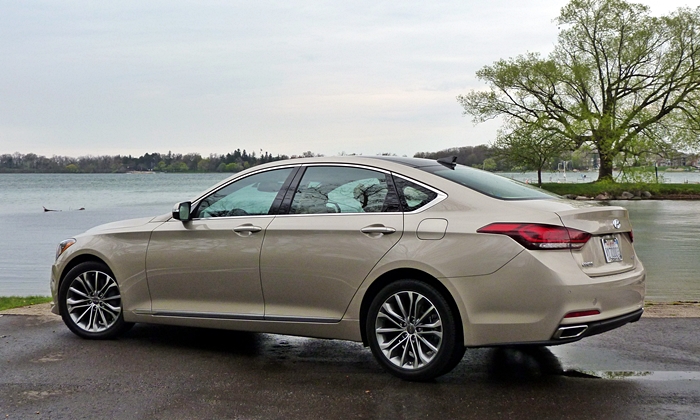
Another good angle despite the excessive visual bulk in the rear fascia. Some BMW influence here.
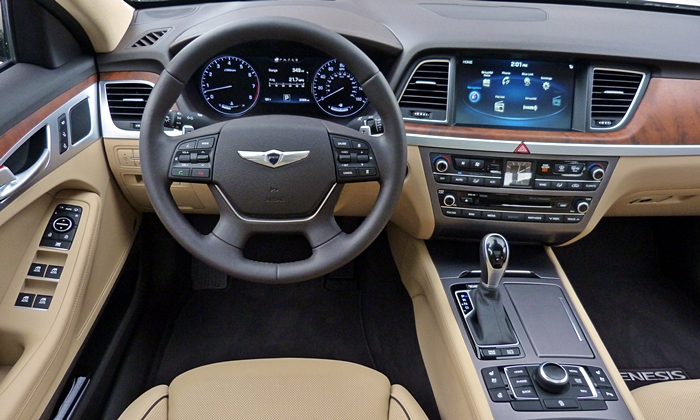
Big knob, touchscreen, or conventional knobs and buttons? All of the above!
| Front seat support & comfort |
 Better
Worse
Better
Worse
|
Most cars in this segment have comfortable seats (the firm, flat ones in the Audi being the exception in my experience). But even in such lofty company the front buckets in the Genesis compare well. They're perhaps the cushiest in the segment, yet they're also properly supportive. In hard cornering the side bolsters (adjustable for the driver) prove more effective than the less form-fitting seats in the Cadillac. The front seats in the previous Genesis were less contoured and lacked effectively large side bolsters.
The headrests in the new Genesis don't adjust fore-aft, so luckily they're not positioned too far forward. Like the rest of the seat they're deepdly contoured and quite cushy.
| Rear seat room & comfort |
 Better
Worse
Better
Worse
|
Unlike in the past, the Cadillac CTS is smaller and lighter than its direct competitors. Instead, the strategy of fielding a larger, heavier car has passed to Hyundai. The new Genesis is about the same length as the old one, and is only an inch longer than the Cadillac (196.5 vs. 195.5 inches). But it rides on a considerably longer wheelbase (118.5 vs. 114.6 inches) and is also significantly wider (74.4 vs. 72.2 inches). These more generous dimensions pay off in about three more inches of rear legroom and over two more inches of rear shoulder room. Based on interior measurements, the Genesis is actually a large sedan, not a midsize.
Still, all is not golden in the back seat of the Genesis. Its cushion is mounted a little too low to provide sufficient thigh support (typical in this segment), and its backrest felt like it was reclined a bit too much.
| Ride smoothness |
 Better
Worse
Better
Worse
|
Even Hyundai execs now readily admit that the chassis of the first-generation Genesis wasn't tuned well. Handling lacked precision, and the ride often felt unsettled. Back in 2009 (before some refinements were made) some TrueDelta members got rid of the cars because they couldn't stand how they rode.
For the 2015 Genesis, Hyundai enlisted the suspension gurus at Lotus Engineering. The resulting tweaks to the spring rates, dampers, and stabilizer bars have yielded a ride as composed as any in the segment, and more absorbant than that in the more aggressively tuned Cadillac. Even some truly awful Detroit-area roads failed to knock the car off its intended path or elicit harsh reactions. The optional adaptive dampers on the 5.0 seemed to take the edge off of small bumps a bit better--the 3.8 felt a little bouncier over some badly cracked pavement--but I didn't drive both cars on the same road. So the difference could have been in the road rather than the dampers.
This said, the car's ride is far from pillowy. The bogies were clearly European.
Noise levels are also about as low as you'll find. Side windows in both rows are fitted with laminated glass as standard equipment. Cadillac offers rear side laminated glass as an option. Most cars in the segment don't offer it at all.
Even with this composed, quiet ride, my impression was that the Genesis still doesn't feel quite as "premium" as the competing Cadillac, BMW, Lexus, or Mercedes. As in Audis, a certain "slickness" and insulation wasn't quite there. But I need some back-to-back drives to confirm this (or quite possibly fail to).
This quibble aside, virtually everyone who drove the new Genesis at the press event was amazed by the new chassis. Whatever Lotus was paid, they earned every cent.
| |
Compared to the CTS |
| Fuel economy |
 Better
Worse
Better
Worse
|
To achieve the stiff body structure behind the impressive safety scores and ride quality, Hyundai added substantial reinforcements, including a brace at every corner of the engine compartment. These plus the relatively large dimensions mean that the new Genesis is substantially heavier than the old one. Equipped with the V8, it's now a hefty 4,541 pounds. The Cadillac CTS went in the opposite direction. Even in Vsport form it's nearly 600 pounds lighter.
Beyond this curb weight, Hyundai also stuck with relatively large non-turbocharged engines rather than switching, like Cadillac, Audi, and BMW, to smaller turbocharged ones.
Given the relatively high curb weight and relatively large engines, the relatively poor EPA fuel economy ratings of the new Genesis should come as no surprise. The 5.0 is estimated to go only 15 miles per gallon in the city, and only 23 on the highway. The CTS Vsport rates just a single mpg better in each case, but it also ranks near the bottom in the segment. Even saddled with all-wheel-drive, the ultra-quick Audi S6 earns EPA ratings of 17/27. The A6 3.0T (also with all-wheel-drive) does a bit better than this, 18/27.
Step down to the Genesis 3.8, and the EPA ratings are more competitive with rear-wheel-drive, 18/29, but are a not-so-good 16/25 with all-wheel-drive.
Even the 18/29 only seems competitive if you ignore that the BMW 5-Series is about as quick as the Genesis 3.8 when fitted with a 2.0-liter turbocharged four. And the 528i is rated 24/34 with rear-wheel-drive and 22/33 with all-wheel-drive.
| Driving position & visibility |
 Better
Worse
Better
Worse
|
The original Genesis had a high, upright driving position. You sit lower in the new car, or the instrument panel is higher. Probably both. The windows certainly aren't as tall. Consequently, the view forward isn't nearly as open. Cars in general have been moving in this direction, but that doesn't mean we have to like it. In this segment, forward visibility is better in most competitors.
The CTS also has visibility issues, but different ones. The view over its instrument panel is more open.
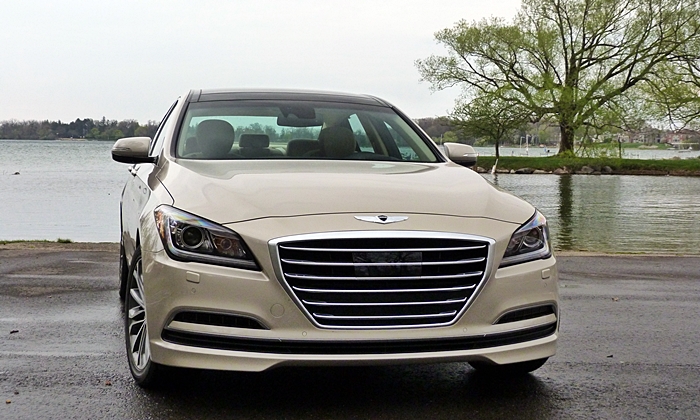
Large angular grille opening has a strong whiff of Audi. No fog lamps--this is the 3.8.
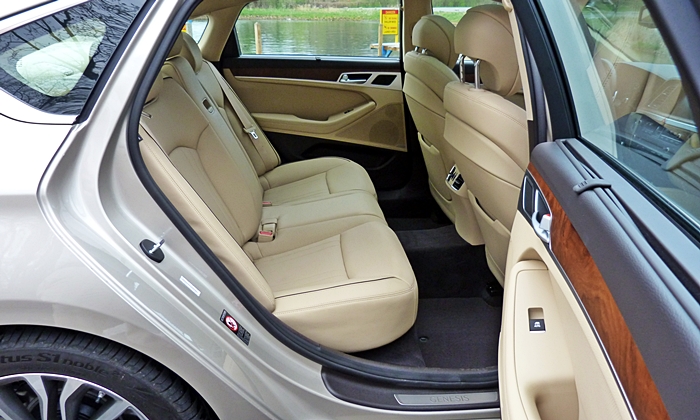
The back seat could be more comfortably positioned, but it's nicely shaped and roomy.
| Cargo capacity |
 Better
Worse
Better
Worse
|
Cargo capacity remains about the same in the new Genesis. While 15.3 cubic feet is about average for the segment, and better than the 13.7 in the CTS, the rear seat in the Genesis cannot fold to expand the trunk. A folding rear seat is available in the Cadillac, Audi, BMW, and Mercedes.
| Brand reputation & image |
 Better
Worse
Better
Worse
|
Objectively, the brand shouldn't matter. But the fact of the matter is that most luxury car buyers will pay more for a brand with a top-shelf reputation, or even insist on this, and Hyundai doesn't have one.
| Dealer practices |
 Better
Worse
Better
Worse
|
Dealers of premium brands treat their customers differently. Hyundai intends for its dealers to provide additional services to Genesis buyers, but the facilities simply aren't in place to provide the same experience as a dedicated luxury car dealer.
| |
Compared to the CTS |
| Exterior styling |
 Better
Worse
Better
Worse
|
The original Genesis had a pleasant enough exterior appearance, but it wasn't distinctive or leading-edge in any way. The new Genesis looks nothing like it. The proportions, the design language, even the shape of the grille--all are completely different. The new look, though a little stiff and bulky through the lower body for my taste, is crisper, more athletic, and much more aligned with the latest design trends. There are shades of Audi in the big grill, strong shoulders, and flowing roof line, but overall the new Genesis looks like nothing else. Decidedly not Audi: the relatively long distance between the front wheel and the passenger compartment. This generally requires a front engine, rear-wheel-drive chassis, which Audi doesn't have.
I especially like how the body side's shoulder flows into the tail lamp. It's not a coincidence that this detail is most obvious with the color of the car I selected for the photos (actually a 3.8, rather than the 5.0 I spent most of my time in).
The Cadillac appears much more trim than the new Genesis. This likely represents the differing goals of the designers. Cadillac wanted a car that appeared athletic. Hyundai wanted one with a big, bold presence on the road.
| Interior styling |
 Better
Worse
Better
Worse
|
The interior styling of the Genesis has changed as much as its exterior styling, but not in the same way. Like the new exterior, the new interior appears more up-to-date. But, unlike the exterior, it's now less distinctive--or less idiosyncratic, to put a more positive spin on it.
The primary influence appears to have been BMW, but with a cleaner integration of elements, additional square inches of wood trim, and piping in a contrasting color on the seats to lend a warmer ambiance. (This warmer ambiance does depend on interior color selection. The car I spent the most time in had light gray upholstery and black wood trim.)
The basic theme might even be overly plain, with nearly straight lines and a minimal number of simple shapes. When I first saw the car at the auto show, my initial impression was that the interior was much less stylish than than the more overtly opulent styling of the Kia K900 (which has another $10,000 to justify).
But, with more exposure, the interior of the new Genesis seems suitably upscale. The materials are of good quality, and the fits are tight and precise. The old car's downscale silver plastic trim plates are gone. Spring for the 5.0 or the 3.8 with the Ultimate Package, and both the wood and the gray aluminum on the center console are the real deal. The matte finish of the former elevates the place a notch or two. The gray aluminum trim...doesn't quite fit aeshetically, at least not in the tan interior.
The Cadillac's interior is much more dramatically styled. Its plethora of materials and colors will appeal much more to some people, much less to others.
| Controls and instruments |
 Better
Worse
Better
Worse
|
Like any car in this segment, the new Genesis has complicated controls. In the Germans, a large knob serves as the primary interface. The Cadillac CTS instead employs a touchscreen (often criticized for its slow responses and confusing layout). The new Genesis has both a knob and a touchscreen. Plus good, old-fashioned knobs and buttons for frequently used functions (like changing radio stations). I need more time in the car to evaluate how well this "all of the above" solution works, but can report that nothing seemed terribly frustrating during my initial drive.
I also need more time to evaluate the nav and audio systems. Two of the former and three of the latter are offered. The tested cars had the top-of-the-line in both cases. I was thoroughly impressed by the Lexicon system in the first Genesis, finding it among the clearest I've ever heard. The Lexicon system in the new car is supposed to be even better. I wasn't initially as impressed with it, but was quite focused on other aspects of the car.
| Powertrain performance |
 Better
Worse
Better
Worse
|
I've already laid out the pieces of the performance puzzle: heavy car, engines without boost. While the Genesis is quick even with the V6--following a hard launch, 60 mph should arrive in about six seconds, compared to low fives with the V8--it's not as quick as Audis and BMWs with the same cylinder count. Instead, the V6 is more a match for their turbo fours, and the V8 more a match for their boosted sixes.
The main performance difference between two engines is at speeds below 20 mph, where the V8 produces a considerably firmer shove. Above that mark, the V6 delivers all the thrust the great majority of owners will ever need. Both engines sound good when hustled, with the V6 actually throatier than the V8.
The lack of low-end grunt from the V6 is a bit of a surprise. With eight ratios, the automatic transmission could include a short first gear. And the engine was redesigned for 2015, gaining a three-stage intake manifold to bump low-end power at some expense to the top end (peak horsepower is down from 333 to 311).
The tested 5.0 suffered from one oddity no one else seems to have reported. When accelerating fairly aggressively over slightly uneven pavement, or even modestly with turning across the same, the rear suspension knocks about (on both sides when heading straight, and only one when turning). This suggests insufficient control of wheel hop. I didn't notice the same with the less torquey 3.8, but also spent less time in it. The new Genesis could have a minor suspension revision in its future.
| Handling |
 Better
Worse
Better
Worse
|
I've rated the handling of the new Genesis 5.0 much worse than that of the CTS Vsport, but this is more a reflection of how aggressively, even joyfully the Cadillac attacks curves than of any shortcomings on the part of the Hyundai. By the company's own admission the Genesis is a different sort of car. Cadillac went small and agile, Hyundai went big and steady.
Even in performance-oriented R-Spec form the first-generation Genesis was a dynamic mess. Hard turns provoked heavy understeer, and even with the R-Spec's ride-killing tune the car never felt tight or precise.
Perhaps thanks to the assist from Lotus Engineering, the new Genesis doesn't suffer from these ills, even with no R-Spec variant (at least not yet; one that pairs the V8 with all-wheel-drive was hinted at). It's no sport sedan in that it lacks the sharp reflexes and agility of the CTS Vsport. This isn't its intended mission. But the Hyundai's electrically assisted steering, while less involving and less nuanced than that in the Cadillac, feels more direct and more naturally weighted than the surprisingly numb racks found in the latest generation of German competitors. Between this steering and a well-tuned suspension, flogging the new Genesis through sweepers comes naturally. The big sedan feels balanced even when aggressively tossed into a curve, and its body motions remain well-controlled even over awful pavement. Apply some throttle mid-turn, and the car progressively oversteers in the time-honored rear-wheel-drive fashion, its tail sliding out to tighten the line, if less readily than it would with a limited-slip differential like the active torque-vectoring one in the CTS Vsport. (Even the Hyundai's degree of oversteer isn't happening in the nose-heavy, emphatically all-wheel-drive Audi A6.) Above all, the new car feels good and inspires confidence the way BMW sedans used to, which was Lotus's primary goal.
Switching from normal to sport mode further firms up the steering, modestly tightens up the adaptive dampers (in the 5.0 with the Ultimate Package), and shifts up to 90 percent of the torque to the rear wheels (with all-wheel-drive). But sport mode also holds the transmission in a lower gear, so it can't be used much of the time without significantly harming fuel economy. Hyundai needs to copy a bit more from Audi and allow drivers to select which systems (drivetrain, steering, suspension) are affected when switching into sport mode.
Even in 5.0 form, the new Hyundai Genesis isn't a hardcore performance sedan like the Cadillac CTS Vsport is. Instead, Hyundai was seeking more of a balance between ride and handling, with additional attention to roominess, and found it. I wish the windows hadn't shrunk so much, and that the fuel economy was better. In just about every other way, though, the new Genesis impresses: up-to-date, more distinctive styling; competitive materials (with the top option package); cushy yet thoroughly supportive front seats; and a top safety rating. To top it all off, for those seeking a combination of handling competence and luxury in a decidedly large sedan the Genesis now drives at least as well as the German competition, quite arguably better.
It would seem that I've buried what might be the biggest news about the new Genesis. After so many years of getting suspensions wrong, Hyundai finally admitted that it needed help, got it, listened to it, and has gotten one really, really right.
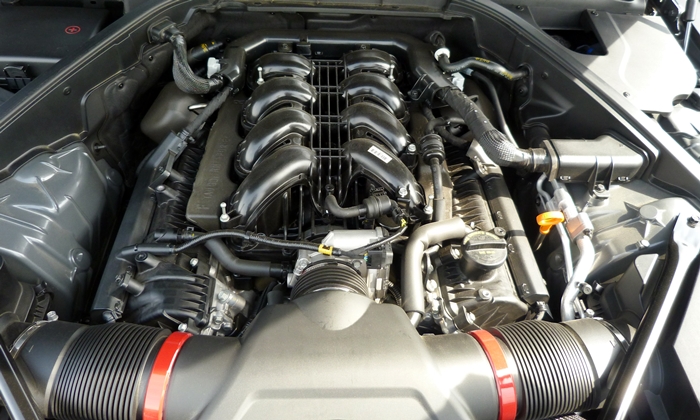
Extensive bracing for handling and safety. With a little dressing up, cover wouldn't be needed.

A usefully large trunk, but unlike in competitors the rear seat cannot fold to expand it.
See more 2015 Hyundai Genesis photos
Hyundai provided two meals and insured, fueled cars to drive at an event for invited media. The Cadillac was driven at a media association event.











